The Hunger Games: Catching Fire – Storytelling as Adaptation and Sequel
Last year, the first film in The Hunger Games saga offered a perfect opportunity to discuss the relationship between a novel, a movie, and the underlying story portrayed in both. Each medium has its comparative advantages and disadvantages; in some ways a book will always be more powerful, while cinema will always outdo prose in others. In adapting the first novel, The Hunger Games movie made changes including restructuring to a linear plot that removes the flashbacks used in Katniss’ internal monologue and trimming out several subplots and minor characters to streamline the 374-page narrative for a 142-minute film – 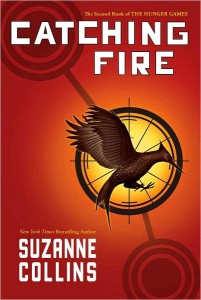 while also expanding the story beyond Katniss’ sole point-of-view to give the audience new and authentic perspective on the Gamemakers, President Snow, and the reality of life in Panem. By doing so the film becomes a different version of the tale than the book, while staying true to the underlying characters, themes, and message of Suzanne Collins’ story.
while also expanding the story beyond Katniss’ sole point-of-view to give the audience new and authentic perspective on the Gamemakers, President Snow, and the reality of life in Panem. By doing so the film becomes a different version of the tale than the book, while staying true to the underlying characters, themes, and message of Suzanne Collins’ story.
The second film in the series, Catching Fire, presents an even more fascinating intersection between book and movie – it must function not only as the adaptation of the second book, but also as the sequel to the first movie. In that regard Catching Fire serves two masters in a manner that The Hunger Games movie did not, and this dynamic potentially could have created internal conflicts in the direction of the film that risked its coherence to the audience. Instead, fortunately, the Catching Fire movie achieves the same success as its predecessor by focusing on the core elements of the underlying story, drawing inspiration at times from the book and at others from the prior film. This gives Catching Fire the strength to stand as a powerful tale in its own right.
Adapting the Catching Fire Novel
Like the first movie, the second necessarily had to simplify certain aspects of the 400-page novel for the 146-minute film. For example, multiple conversations about Snow’s threat and the role of the Victors are condensed into the single conversation in the loft of the District 11 ministry, the bridal dress photoshoot and Katniss’ feigned interest in a fashion design career are removed, and Effie’s regrets about the injustice of the Quarter Quell stand in for scenes with Katniss’ full prep team. In the book, the Victors keep the charade of Katniss’ pregnancy ongoing during the Games to continue to exploit the sympathies of the viewers in the Capitol; in the movie Peeta’s “baby bomb” serves only as a last-ditch ploy to try to bluff Snow into cancelling the Games, and no one bothers playing along after it doesn’t work. Rather than a signal from Plutarch based on the District and number of rolls sent by parachute, the Victors signal their own timeline for extraction from the arena with Beetee’s remark about waiting six more hours that is overheard by Plutarch. The novel’s emphasis on the media coverage of the Victors’ lives, experienced from Katniss’ internal monologue, is simplified so that the cover story that Gale is her “cousin” is unnecessary, streamlining the Capitol’s fascination to a focus upon her sister Prim, for whom she had famously and publicly volunteered. These changes allow the movie’s plot to flow swiftly, without the need for clunky exposition in dialogue to explain details that flow more readily in internal monologue.
The movie also glosses over the timeline references included in the book, avoiding the need to find a solution to explain the passage of time between major events. In the novel, the Victory Tour is six months after the 74th Games. To keep Katniss out of action for much of the duration until the Quarter Quell Reaping, the book includes a segment in which the District 12 fence is re-electrified. This results in Katniss climbing a tree and falling, injuring her foot and hobbling her from any meaningful public appearances – or opportunities to cause trouble – until the plot picks up steam again. 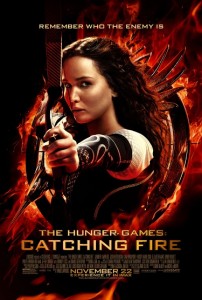 In the movie, the audience experiences the Victory Tour and Reaping very nearly back to back, without sidelining Katniss from the action. This change keeps the pace of the film moving compared to the period of downtime offered by the book. It also may provide a hint for the forthcoming adaptations of Mockingjay, which also uses the narrative technique of injuring Katniss to keep her out of commission while events proceed around her; the Mockingjay movies similarly could use other characters’ points-of-view and a compressed timeline to minimize the period in which Katniss is sidelined.
In the movie, the audience experiences the Victory Tour and Reaping very nearly back to back, without sidelining Katniss from the action. This change keeps the pace of the film moving compared to the period of downtime offered by the book. It also may provide a hint for the forthcoming adaptations of Mockingjay, which also uses the narrative technique of injuring Katniss to keep her out of commission while events proceed around her; the Mockingjay movies similarly could use other characters’ points-of-view and a compressed timeline to minimize the period in which Katniss is sidelined.
Some of the more effective moments in Catching Fire, though, are given comparable treatment in both the book and movie. In the novel, the engagement of Katniss and Peeta is not shown “live” in her narration, but only relayed as a brief memory in internal monologue. In the movie, the proposal is also portrayed quickly and “offscreen” by means of a brief glimpse at a Caesar Flickerman broadcast. In the book, Katniss is about to shoot Enobaria with an arrow when she recalls, in her internal monologue, Haymitch’s admonition and decides to tie the wire to her arrow and blow open the arena instead. The movie changes the potential target from Enobaria to Finnick – which allows the moment to connect to scenes with Snow and Plutarch beyond Katniss’ perspective – and shifts the reminder to “remember who the real enemy is” into his line of dialogue, but the impact on Katniss’s realization and decision is the same.
In other ways, the movie reinvents aspects of the novel’s events in order to create a cinematic experience that seeks to mimic the effect of the first-person narrative by Katniss in the prose. In the book, for example, Katniss encounters the District 8 refugees who tell her that District 13 is not destroyed and that the footage shown on television is outdated stock footage, and Katniss slowly unravels this mystery for herself. In the movie, the audience experiences the mystery in two otherwise unexplained namedrops of District 13, one from Snow at the beginning and the other from Plutarch at the end. In the book, Katniss misses several clues about the latent support for the rebellion among the Capitol crowd, such as mockingjay pins and Plutarch’s watch at the party; in the movie, the audience sees a single mockingjay graffiti in the train tunnel and a few oblique lines of dialogue from Plutarch to Katniss at the party, preserving a similar sense of surprise at the revelations aboard the hovercraft after the arena extraction. Likewise, Katniss in the book does not recognize Haymitch’s hints to her about his preexisting friendship with Finnick and other Victors; the movie also includes subtle hints of the connection between Haymitch and Finnick leading up to the reveal of the bangle on Finnick’s wrist in the arena.  By using these narrative techniques, the movie gives members of the audience who haven’t read the book a comparable perspective on the unfolding story to readers of Katniss’ internal monologue.
By using these narrative techniques, the movie gives members of the audience who haven’t read the book a comparable perspective on the unfolding story to readers of Katniss’ internal monologue.
Another area in which the movie departs from the book while seeking to preserve a comparable emotional impact is in its portrayal of Katniss’ relationships with Gale and Peeta. She is often not particularly perceptive about these relationships, whether it’s how they feel about her, how she feels about them, or the traits of each young man to which she finds herself drawn. In the book, this dynamic is conveyed primarily through her sometimes-clueless internal monologue and occasional lines of dialogue – so that the reader often recognizes the truth of what is going on long before Katniss herself does. The movie, by contrast, is not limited to showing the story only through Katniss’ eyes, so the characters and their feelings for each other can be portrayed with body language and other visual cues that the audience will pick up on even when Katniss doesn’t. The underlying natures of the relationships are unchanged, but how they’re shown within the story is adapted to the medium.
In one sense Gale is Katniss’ soulmate: he is the man who knows her better than anyone, certainly better than she knows herself. In the opening scene when Katniss experiences her flash of PTSD, Gale instantly soothes her. He is the only character who argues with her and draws a reaction of vulnerability or fear, rather than anger. Instead of internal monologue to show Katniss’ recognition of her feelings for him, the movie adds a goodbye kiss on the hillside just prior to the Quarter Quell Reaping.
In another way, though, Gale and Katniss are fundamentally different – she wants to protect people and he wants to fight. Katniss doesn’t want a revolution; she just wants to keep her loved ones safe. Gale’s anger at the Capitol is subtle in The Hunger Games, but wide open in Catching Fire; he points out to her that protecting their families still leaves everyone else in District 12 to a life of suffering. In the Catching Fire book, Katniss’ overpowering fear of Snow’s threat and then the Quarter Quell keeps her from recognizing the deep divide lurking between them. The Catching Fire movie offers an interesting hint to the audience, though, in the way it reinvents a moment in the story. In the book, Gale is whipped by the new Head Peacekeeper for poaching – something he has in common with Katniss. In the movie, Gale leaps at Commander Thread and tackles him to prevent him from whipping an elderly woman – an aggressive and violent act that makes him different from Katniss.  While Katniss wants to protect people, she acts defensively and reactively; Gale, on the other hand, takes the offensive against tyranny. Later, in Mockingjay, their willingness to punish their enemies and make sacrifices to win the war will push them even farther apart.
While Katniss wants to protect people, she acts defensively and reactively; Gale, on the other hand, takes the offensive against tyranny. Later, in Mockingjay, their willingness to punish their enemies and make sacrifices to win the war will push them even farther apart.
What Peeta presents to Katniss is something very different: although he may not have the lifelong bond that Gale does, he offers Katniss an unconditional love that puts her happiness above his own. Because self-awareness isn’t her strong suit, the book at times uses unambiguous lines of dialogue to make sure she doesn’t miss important points, such as Haymitch explaining to her that Peeta’s frustration at the suggestion of the marriage proposal was because he wanted her feelings to be real, or Peeta openly admitting that his nightmares involve losing her or his desire to freeze the rooftop moment with her and live in it forever. In the movie, these overt expressions are substituted with visual moments that convey the same emotions, such as Peeta’s body language when he storms from the train car after Katniss’ marriage suggestion and his facial expressions when he comforts her in bed after her nightmares or when he sits with the unconscious Gale because he knows Katniss needs a brief respite. Although his feelings for her aren’t portrayed as obviously to Katniss, they are fully transparent to the movie audience.
At the same time, the movie makes certain to emphasize that Peeta is a worthy partner to Katniss, who is growing into not only an action heroine of the arena but a symbol of the incipient rebellion. His bold offer in District 11 is nearly as risky as her ploy with the berries. He handles public speaking with ease, on the Victory Tour and in putting on his acting face for the “baby bomb” on live television. He volunteers at the Reaping, just as she did. In the Quarter Quell arena, he holds his own as a Victor; more on that below. But he also understands the role Katniss must undertake, and he supports her in it. In the book, Katniss sees the floor of the training center cleaned up after Peeta’s individual skill for the Gamemakers, and she learns about his painting of Rue from Peeta after the fact. In the movie the artwork remains exposed on the floor, and her tearful reaction instigates Katniss’ own rebellious effigy of Seneca Crane. By reinventing this moment in that way, the movie not only demonstrates that Peeta’s strength in the rebellion ahead will come not from violence, like Gale, but from his empathy for suffering – it also shows Peeta’s capacity to inspire Katniss to greatness.
Creating the Sequel to The Hunger Games Movie
The simplest connections between the first movie and the second are the visual and audio continuity between them. The color palette and look of District 12 is familiar, as is Caesar Flickerman’s stage and the Gamemakers’ control room. The three-finger salute returns, as does Rue’s whistle. The anthem of Panem is heard repeatedly, and the cannon to mark the deaths in the arena is the same. These little touches preserve the feeling of inhabiting the same world as the first movie.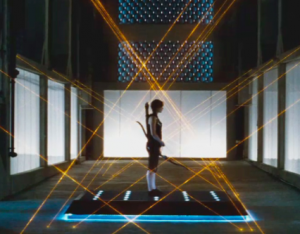
Many of the changes from the first film to the second reinforce their connections. The Peacekeepers have upgraded armor and gear, signaling Snow’s increasing crackdown. The other tributes in the Games are now Victors, and many of them display a confidence and strength that befits their stature in the Capitol. The visuals associated with Primrose Everdeen mark a deliberate contrast to the first movie, even though only one year has passed in the story: instead of a scared and timid young girl, she now dresses and acts like an older and more confident young woman. With the rebellion simmering in the Districts, Catching Fire’s movie shows the audience the trajectory on which Panem and the characters find themselves.
Structurally the second film mirrors elements of the first, as well, providing another layer of integration. Several times the audience cuts away from Katniss’ perspective to Panem’s television coverage, including Caesar Flickerman’s program and the broadcast of the Tribute Parade – complete with Caesar’s abominable showmanship in expressing his fondness for the District 12 Victors and his “lethal lovers” nickname for them. The movie also cuts away to Plutarch and the Gamemakers manipulating events in the arena, just as Seneca Crane did in the first film. For example, we learn that the Cornucopia island spinning was not set on a timer but rather a deliberate action by Plutarch – which he surreptitiously and conveniently ends just as Katniss splashes out into the water alone. The first movie included a single cutaway to Gale in District 12 during the Games, to show him witnessing an intimate moment in the cave, and ended with Gale celebrating Katniss’ homecoming with Prim on his shoulders. The second movie likewise uses a single moment with Gale while Katniss is away, with him washing his hands in the mine as news of the engagement airs on television, and ends with Gale at Katniss’ side to deliver the news of the fate of District 12.
As with the first movie, Catching Fire uses additional scenes outside Katniss’ point-of-view to reveal the dangerous politics of Panem. Snow gives Plutarch a similar warning about the power of hope that he gave Seneca. Two brief scenes with his granddaughter highlight the influence of Katniss as a celebrity. And Snow is so fearful of rebellion in the Districts that he misjudges the situation to conclude that a crackdown will cause the Districts to give up rather than explode in revolution. 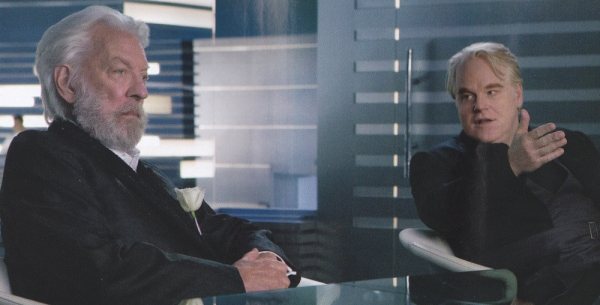 Of course, some of Snow’s miscalculations are deliberately provoked by Plutarch, the Head Gamemaker who is playing a deadly political chess match with the President; every move that Snow thinks will lead the public to turn against the Victors is actually meant to turn them against Snow. As mentioned in our review, nearly every line of dialogue Plutarch speaks to Snow is actually about the rebellion. In his path toward provoking revolution, though, Plutarch is no guardian angel: his suggestions prompt the vicious crackdown in the Districts and the slaughter of popular Victors in the Quarter Quell Games, among others. Just as Haymitch’s suggestion to Seneca led to the young-love twist that kept Katniss alive and motivated longer in the 74th Games, now Plutarch is manipulating events in ways that profoundly affect Katniss. No wonder the emotion she feels on the hovercraft at the end of the film is not success, but betrayal.
Of course, some of Snow’s miscalculations are deliberately provoked by Plutarch, the Head Gamemaker who is playing a deadly political chess match with the President; every move that Snow thinks will lead the public to turn against the Victors is actually meant to turn them against Snow. As mentioned in our review, nearly every line of dialogue Plutarch speaks to Snow is actually about the rebellion. In his path toward provoking revolution, though, Plutarch is no guardian angel: his suggestions prompt the vicious crackdown in the Districts and the slaughter of popular Victors in the Quarter Quell Games, among others. Just as Haymitch’s suggestion to Seneca led to the young-love twist that kept Katniss alive and motivated longer in the 74th Games, now Plutarch is manipulating events in ways that profoundly affect Katniss. No wonder the emotion she feels on the hovercraft at the end of the film is not success, but betrayal.
In other ways, the Catching Fire movie differs from the book because of its role as a sequel to the first film. Because Madge and the Mayor were omitted from the first movie, Katniss learns of the riots in other Districts through glimpses of the Peacekeeper’s booth on the train rather than in the Mayor’s house. Because Katniss found the mockingjay pin herself in the Hob, rather than as a gift from Madge, the second movie has no reason to connect the 75th Games to the previous Quarter Quell that included Haymitch’s victory and the death of Madge’s aunt. Presumably that is also why the movie omits the scene in which Katniss and Peeta watch footage of Haymitch’s Games – because much of the emotional impact of that scene lies in its resonance with the backstory connections between Madge’s family and Katniss’ mother, which is absent in the streamlined movie narrative focused on the present-day tale. 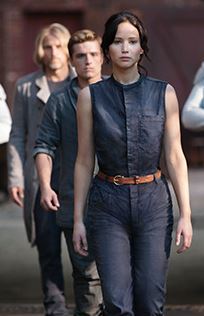 Likewise, just as the first movie removed references to one of the Avoxes being a former acquaintance of Katniss, the second movie skips any mention of the friendly Peacekeeper Darius suffering the same fate.
Likewise, just as the first movie removed references to one of the Avoxes being a former acquaintance of Katniss, the second movie skips any mention of the friendly Peacekeeper Darius suffering the same fate.
Perhaps one of the biggest changes from the book involves Peeta’s role in the arena in the Catching Fire movie. This is a direct consequence of the first movie, which departed from the first book by not having Peeta lose his lower leg to the muttations in the final frantic melee. That physical vulnerability motivated a great deal of Katniss’ fear for his safety in the second book, but those motivations are not longer applicable in the second movie with a fully hale Peeta arriving to the arena. As discussed in our review, the Catching Fire film successfully adapts Peeta into more physically capable character without undermining his core personality or obstructing the emotional importance of his role in Katniss’ own heroic arc.
Finally, it is Katniss herself who remains the constant center of both The Hunger Games and Catching Fire films. In both movies her initial inclination is to struggle alone, just as she has so often done in her life. Her mistrust is strong, such as when Peeta joins the Career pack in the 74th Games, before she figures out he did it to protect her, and when Finnick immediately teams up with her in the 75th Games, even after he performs CPR to save Peeta’s life. Yet in both films she ultimately realizes that she cannot succeed without allies, first Haymitch and Peeta and then Finnick and Beetee. As the Girl on Fire transitions toward the rebellion’s Mockingjay, her alliances with Team Katniss will grow even more important in the events ahead.
B.J. Priester is editor of FANgirl Blog and contributes reviews and posts on a range of topics. A longtime Star Wars fandom collaborator with Tricia, he is editing her upcoming novel Wynde and collaborating with her on several future projects set in that original universe. He is a law professor in Florida and a proud geek dad.









